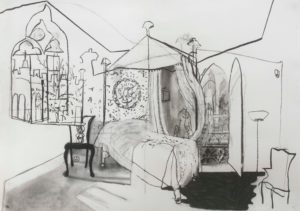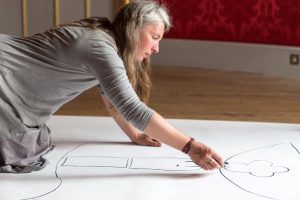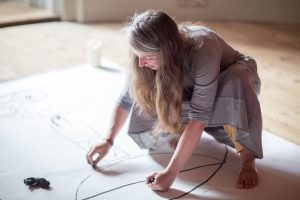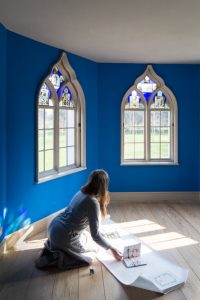Strawberry Hill House offers a range of opportunities to get involved in activities taking place in all areas of the House and Garden.
Drawing the Blue Bedchamber at Strawberry Hill House
A personal account by Katie Sollohub – First Prize Winner of the Derwent Drawing Prize April 2020
I was first invited to draw in Strawberry Hill House after my residency at nearby Turner’s House, which ended with a solo exhibition at the Stables Gallery, Orleans House, in May 2016. I was delighted with the invitation, as I had never seen the inside of the house, despite having walked or driven past it on numerous occasions, on my way to Twickenham; it had always fascinated me.
I was given the guided tour as my introduction, and so learned more of the stories around the building of the house, and the life of Horace Walpole; and I was gripped, from the beginning. As an artist, I was taken with it visually of course, being all about space, light, mood and detail, telling a story as you walk through it. I was also captivated by the character of the man who built it, from his gothic novels to his obsessive collecting of treasure – I loved the idea that he would open his home up as a museum, let people wander through.
There were so many rooms I loved, from the gold gilded, red gallery and subtle light of the tribune, to the tiny wallpapered writing room at the top of the stairs. Each day I visited (and there were many, as all the work was done in situ), I would choose a different room to be in – following Walpole’s own daily motto “Fare que sentiat” (‘Do as you feel’).
On the day I drew the Blue Bedchamber, it was a warm, sunny day, the windows were fully open – they slide into the wall cavities, so there are no panes of glass or window frame to be seen – and the curtains around the bed were blowing in the wind. As I drew the outside, it seemed as if it was coming into the room, so I let it. In my drawing process, I usually let the line go for a walk, following the passage of my eyes, mapping the space. Charcoal is the most sensitive, immediate extension of my hand, responsive to touch, my drawing medium of choice. So my line can search and slide across the page, reaching into corners, weaving in and out of the spaces, crawl around the edges. I see the whole, as well as the details, as if my eyes are constantly coming in and out of focus. So too does the drawing. One minute clear, one minute lost in the process of looking. I choose to leave most of the traces of this exploration, removing only what seems insensitive, unnecessary, to the drawing. As the work evolves, my eye, and hand, might rest upon one area more than another. I remember becoming fascinated with the tailor’s dummy who stood hidden behind the open door – should I include her, or leave her out, what story would she have to tell? In the end she stayed, she inhabited the room, ghost like, in and out of the shadows, like the spirit of the wind. The open door to the right leads the eye out of the room, there always has to be a way out of my rooms. But it is dark through that door, so I am not sure I will be going there. Instead, I stay here in the light, the brilliance of colour, the fresh air of the window, the trees and blossom outside. This is how I draw, in situ, my hands following my eyes, following my imagination, making choices, creating spaces, and just enough of a narrative that those looking on might be tempted to step into the drawing too, and explore it for themselves.
In practical terms, I work on the floor, in situ, spreading out a dust sheet. I have to be there to feel the space, to look at it all around me. I work large, typically A1 or larger, so my whole body has to move in the process. As mentioned above, I use charcoal, I take a line for a walk, I let my hands follow my eyes, and let the drawing evolve. Most often I will rub out layers with a cotton rag, let the dust become part of the space, and draw again, changing viewpoints, shifting between space and detail, line and texture. I take pleasure in drawing the modern day plug socket in the skirting board, or shaping the elegant legs of the period chairs. Where shadows fall, I press harder with my hand, charcoal shapes spilling across the paper. I use a rubber to carve back into the grey, to draw the light back in, or create a feeling of lightness, of softness, in fabric or surface.
For more information on Katie’s work please visit: www.katiesollohub.co.uk
‘Blue Bedchamber’ is now sold, through the Derwent exhibition



